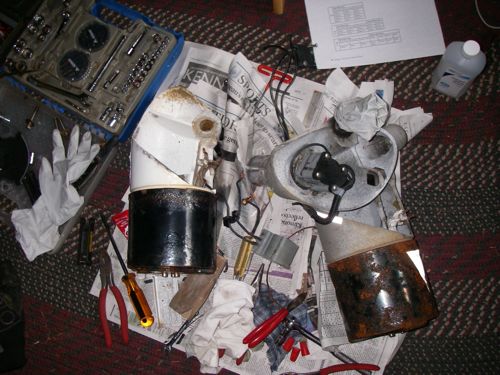Yesterday morning, I put our newly repaired wind generator back on the tower and hoisted it back into position. That afternoon, when the southerly breeze freshened, the green charging lights came on, and wind power returned to our “homestead.” I successfully repaired the wind generator in a process of which Doctor Frankenstein would have been proud.
In 2013 we removed our newer W100 generator from the tower and replaced it with the H40 that had been in place when we moved here. I had repaired it, and planned to use it to provide our power while the W100 underwent warranty repairs. Before sending it off to the company, however, we learned that the company had disappeared. I set the damaged generator in the shed and thought little of it until the H40 malfunctioned recently (see Tilting Windmills).
Monday, we lowered the tower for a second look inside the wind generator. We’d put it back up prematurely before—all indications pointed toward damage inside the turbine itself. Tuesday, I opened it up and got into the brush box.
This is a tricky maneuver. I have two manuals for the generators, one of which describes an early version of the H40. The other concerns the W100, but provides almost no help for repairs; any problems require shipping the machine off to the company. The older manual shows an exploded view of the brush box—too exploded, as the earlier models had a stack of brush cartridges that form a box. The later models, including ours, has fused cartridges, making brush adjustments and removals trickier. It also advises carefully inspecting a certain part. Said part does not appear in the exploded diagram, nor does the name of the part appear anywhere in the manual, except for the advice above!
Still, I was determined. I got inside and found damaged brushes that no longer made proper contact.
I found a company in Colorado that sells parts for these generators. They will gladly ship parts to Alaska via UPS Ground, at a bargain rate—merely a few dollars more than the cost of the part itself! For that princely sum, instead of picking it up at the local Post Office, we have to go out to the airport to pick it up.
I thought about it, then figured out how to change the brushes, and where to get them: inside the burned out hulk of the W100. I cracked it open and dug around in its innards. I found the brushes there in good enough shape that I combined the two sets, installed them in the W100’s brush box, and installed it all in the H40. Frankenstein’s monster.
And, like the famous creature, when I hooked up its electrodes and sent it out in the appropriate weather, it walked. In the words of the over-excited Dr. Frankenstein in the classic 1930’s film: “It’s Aliiiiiiiive!”


good deal – making do with what you have – must be an Alaskan thing
Almost, Linn. The fact that I did not use duct tape as part of the repair may have disqualified this as a truly Alaskan project. Although, the nose cone we replaced had been patched with duct tape for several years, so maybe I get a pass?